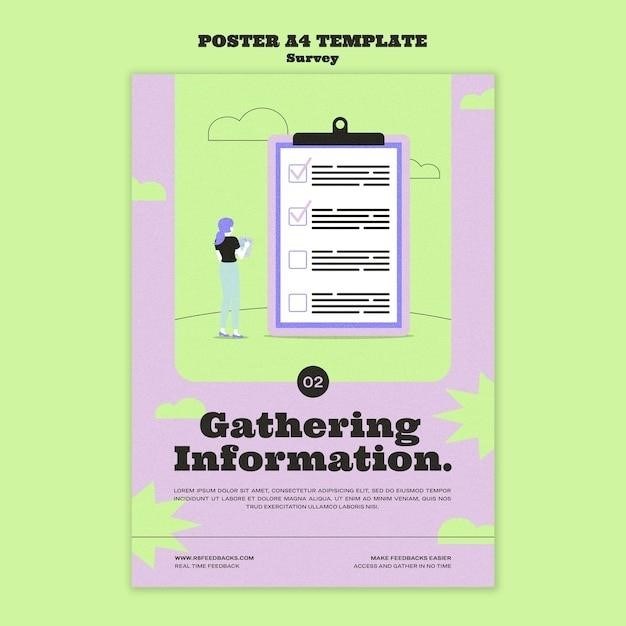Employee Code of Conduct PDF⁚ A Comprehensive Guide
An Employee Code of Conduct PDF is a vital document for any organization, outlining ethical and legal guidelines for employee behavior․ This guide provides a comprehensive overview of its importance, key components, benefits, creation process, and sample templates․ By understanding and implementing a robust code of conduct, companies can foster a culture of integrity, minimize legal risks, and ensure a respectful and productive work environment․
Introduction
In today’s complex business landscape, a well-defined Employee Code of Conduct is crucial for organizations of all sizes․ This document serves as a guiding principle for employees, outlining acceptable behavior, ethical standards, and legal compliance․ An Employee Code of Conduct PDF provides a readily accessible and easily shareable resource, ensuring clarity and consistency across the organization․ It encompasses a broad range of topics, from workplace conduct and ethics to data security and conflict of interest, providing a framework for responsible and ethical decision-making․
Importance of an Employee Code of Conduct
A comprehensive Employee Code of Conduct is essential for several reasons․ It serves as a foundation for a strong ethical culture, promoting integrity and responsible behavior among employees․ By clearly outlining expectations and consequences, it helps prevent misconduct and legal issues, minimizing liability risks for the organization․ Additionally, it fosters trust and transparency, both internally among employees and externally with stakeholders, enhancing the company’s reputation and building a positive brand image․ A well-defined code of conduct provides a clear framework for ethical decision-making, ensuring consistency and fairness in employee actions․

Key Components of an Employee Code of Conduct
A well-structured Employee Code of Conduct should encompass several key components․ It should clearly define acceptable workplace conduct, including ethical behavior, dress code, and communication standards․ Data security and confidentiality protocols are crucial, especially for sensitive information․ Addressing conflicts of interest, such as personal gain influencing professional decisions, is essential․ Compliance with relevant laws and regulations, including anti-discrimination and harassment policies, must be explicitly stated․ Finally, fostering a respectful workplace environment, free from discrimination, harassment, and bullying, is paramount․ These components ensure a comprehensive framework for ethical and legal behavior in the workplace․
Workplace Conduct and Ethics
The “Workplace Conduct and Ethics” section of an Employee Code of Conduct PDF outlines the fundamental principles governing employee behavior․ It clarifies expectations regarding professionalism, integrity, and ethical decision-making․ This section typically addresses issues such as conflict resolution, respectful communication, and appropriate use of company resources․ It emphasizes the importance of adhering to company values, upholding ethical standards, and acting with honesty and fairness in all workplace interactions․ By establishing clear guidelines for ethical conduct, companies promote a culture of integrity and accountability․
Confidentiality and Data Security
The “Confidentiality and Data Security” section of an Employee Code of Conduct PDF outlines the company’s commitment to protecting sensitive information and ensuring data privacy․ It addresses the handling of confidential company data, customer information, and trade secrets․ Employees are expected to understand and comply with data security policies, including access control, password management, and secure data storage practices․ The section emphasizes the importance of safeguarding information from unauthorized access, disclosure, or misuse, and outlines procedures for reporting data breaches or security concerns․ By establishing clear guidelines for data security, companies minimize risks associated with data leaks and maintain the trust of stakeholders․
Conflict of Interest
The “Conflict of Interest” section of an Employee Code of Conduct PDF addresses situations where an employee’s personal interests could potentially compromise their professional judgment or the company’s best interests․ It outlines the company’s policy on disclosing and managing potential conflicts, including financial interests, personal relationships, and outside employment․ Employees are required to disclose any potential conflicts to their supervisor or designated authority, allowing the company to take appropriate steps to mitigate risks․ The section may also outline procedures for recusal or avoidance of situations where a conflict of interest could arise, ensuring that decisions are made based on ethical and professional considerations․
Compliance with Laws and Regulations
The “Compliance with Laws and Regulations” section of an Employee Code of Conduct PDF emphasizes the company’s commitment to upholding legal and regulatory standards in all aspects of its operations․ It outlines the company’s expectations for employees to familiarize themselves with applicable laws and regulations, including anti-discrimination laws, labor laws, environmental regulations, data privacy laws, and industry-specific rules․ It clarifies the company’s stance on bribery, corruption, and other unethical practices, emphasizing the importance of ethical conduct and compliance with all legal requirements․ The section may also refer to resources available for employees to seek guidance on legal and regulatory matters․
Respectful Workplace Environment
A well-defined Employee Code of Conduct PDF emphasizes the importance of creating a respectful and inclusive workplace environment․ This section outlines expectations for employee behavior, including treating colleagues with courtesy and respect, regardless of their background, beliefs, or personal characteristics․ It promotes open communication, encourages respectful dialogue, and prohibits harassment, discrimination, and bullying․ The section may also address appropriate use of company resources, including technology and social media, ensuring that interactions remain professional and respectful․ It aims to foster a positive and productive work environment where all employees feel valued and respected․
Benefits of a Well-Defined Code of Conduct
A well-defined Employee Code of Conduct PDF offers numerous benefits for both the organization and its employees․ It provides clear guidelines for ethical behavior, promoting a culture of integrity and responsibility․ By establishing expectations and consequences, it helps minimize legal risks and protect the company from potential lawsuits․ Moreover, a strong code of conduct enhances workplace culture, fostering trust, transparency, and a sense of shared values among employees․ It can also contribute to attracting and retaining top talent, as individuals seek to work in ethical and responsible environments․
Promoting Ethical Behavior
A well-crafted Employee Code of Conduct PDF serves as a cornerstone for promoting ethical behavior within an organization․ It establishes clear guidelines and expectations for employee conduct, fostering a culture of integrity and accountability․ By outlining principles of honesty, fairness, and respect, it provides a framework for decision-making and guides employees in navigating complex ethical situations․ The code also serves as a reference point for employees, reminding them of their responsibilities and the consequences of unethical actions․ This proactive approach helps prevent misconduct and encourages employees to make ethical choices in their daily work․
Enhancing Workplace Culture
An Employee Code of Conduct PDF plays a crucial role in enhancing workplace culture by establishing a shared understanding of values and expectations․ It promotes a sense of community and belonging, where everyone is aware of the standards of behavior that are expected․ The code can help create a more positive and respectful work environment, where employees feel valued and supported․ It also provides a framework for addressing issues of harassment, discrimination, and other forms of misconduct, creating a safer and more inclusive workplace for all․ By fostering a culture of ethical behavior, the code contributes to a more harmonious and productive work environment․
Minimizing Legal Risks
A well-defined Employee Code of Conduct PDF serves as a shield against legal risks․ It outlines clear expectations for employee behavior, ensuring compliance with relevant laws and regulations․ This helps prevent potential legal issues arising from misconduct, such as discrimination, harassment, or data breaches․ By establishing a framework for ethical decision-making and outlining disciplinary procedures for violations, the code provides a clear roadmap for navigating complex situations․ It also acts as a valuable resource for managing potential disputes and mitigating liability, ultimately safeguarding the organization from legal repercussions․
Building Trust and Transparency
An Employee Code of Conduct PDF fosters a culture of trust and transparency within an organization․ By clearly outlining ethical expectations and values, it demonstrates the company’s commitment to integrity and responsible conduct․ This transparency builds trust among employees, as they understand the standards they are expected to uphold and the consequences of violating those standards․ It also fosters trust with stakeholders, such as customers and investors, who can see that the company is committed to ethical practices․ This transparency builds a strong foundation for ethical decision-making and promotes a positive and responsible work environment․
Creating an Effective Employee Code of Conduct
Crafting an effective Employee Code of Conduct PDF requires careful consideration and a strategic approach․ It should be clear, concise, and easily understood by all employees․ The language should be straightforward and free from jargon, avoiding ambiguity․ Specific examples and real-life scenarios can help illustrate the application of the code in various situations․ Regular communication and training are crucial to ensure employees are aware of the code and its importance․ Finally, establishing enforcement and disciplinary procedures for violations provides a clear framework for addressing misconduct, promoting accountability, and reinforcing the code’s significance․
Clear and Concise Language
Clarity is paramount when drafting an Employee Code of Conduct PDF․ The language should be straightforward and easily understandable by all employees, regardless of their background or level of experience․ Avoid using jargon or technical terms that may be unfamiliar to some individuals․ The document should be written in a concise and direct manner, eliminating unnecessary verbiage and ensuring that key points are communicated clearly and effectively․ This approach promotes comprehension and ensures that employees fully grasp the expectations and standards outlined in the code․
Specific Examples and Scenarios
To enhance the practical application of an Employee Code of Conduct PDF, incorporating specific examples and scenarios is crucial․ These real-life situations provide employees with tangible illustrations of how the code applies to their daily work․ By presenting hypothetical scenarios that address common ethical dilemmas, the document clarifies expectations and helps employees navigate complex situations․ This approach fosters a deeper understanding of the code’s principles and encourages employees to make ethical decisions in their interactions with colleagues, clients, and the organization as a whole․
Regular Communication and Training
Beyond simply creating an Employee Code of Conduct PDF, consistent communication and training are essential for ensuring its effectiveness․ Regular communication about the code’s contents, updates, and relevant policies keeps employees informed and engaged․ Training sessions provide opportunities for employees to actively engage with the code, ask questions, and gain a deeper understanding of its principles․ This proactive approach fosters a culture of ethical awareness and encourages employees to uphold the code’s standards in their day-to-day work․
Enforcement and Disciplinary Procedures
An effective Employee Code of Conduct PDF must include clearly defined enforcement and disciplinary procedures․ This section outlines the process for investigating alleged violations, the potential consequences of misconduct, and the appeals process․ By outlining these procedures in advance, employees understand the seriousness of adhering to the code and the potential consequences of non-compliance․ This transparency fosters a culture of accountability and ensures that disciplinary actions are applied fairly and consistently․
Sample Employee Code of Conduct PDF Templates
Numerous resources offer sample Employee Code of Conduct PDF templates to assist organizations in creating their own documents․ These templates provide a foundation for incorporating essential elements, including company values, ethical guidelines, and disciplinary procedures․ Organizations can adapt these templates to align with their specific industry, size, and organizational culture․ By leveraging these resources, companies can streamline the development process and ensure their code of conduct effectively addresses their unique needs․
A well-defined Employee Code of Conduct PDF serves as a cornerstone for ethical and legal compliance within an organization․ It establishes clear expectations, promotes a positive work environment, and minimizes legal risks․ By implementing a comprehensive code of conduct, companies can foster a culture of integrity, respect, and accountability, ultimately contributing to a more successful and sustainable business․
